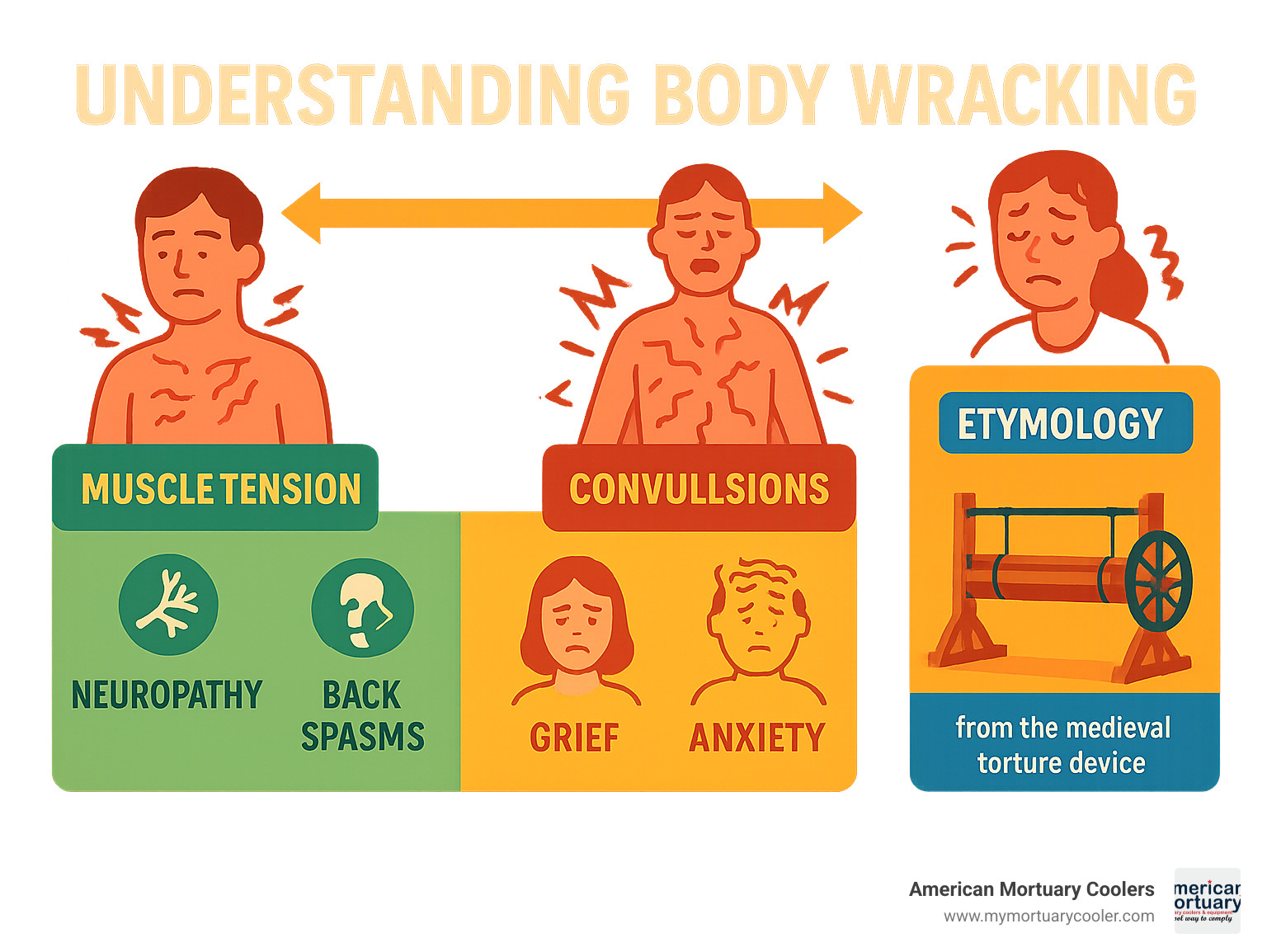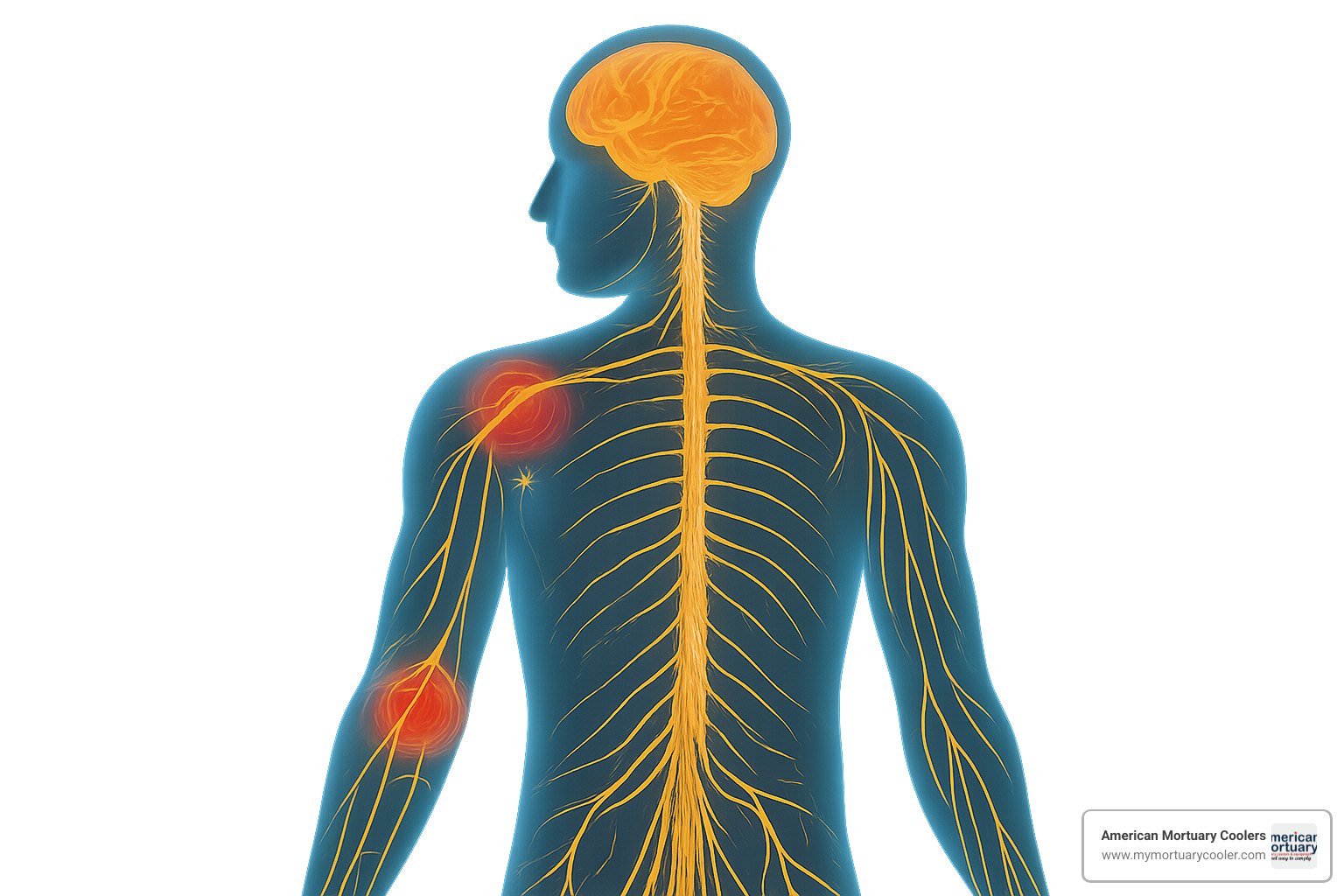Understanding the Complex Nature of Body Wracking
When you hear the term body wracking, it describes intense physical or emotional pain that seems to grip and shake your entire being. This powerful phrase captures experiences ranging from severe muscle spasms and nerve pain to overwhelming grief that manifests physically.
Quick Definition:
- Body wracking = severe pain or distress that affects the whole body
- "Rack" comes from the medieval torture device that stretched victims
- Common usage: "wracked with pain," "nerve-racking," "racking sobs"
- Medical context: muscle cramps, neuropathy, back spasms
- Emotional context: grief, anxiety, guilt that creates physical symptoms
The word "rack" originally referred to the medieval torture device that stretched prisoners until their joints dislocated. Over time, this evolved into describing any intense suffering that grips the entire body.
According to the NIH, an estimated 20 million people live with peripheral neuropathy alone - a condition that can cause truly nerve-racking pain affecting daily life. Back pain has reached epidemic levels, with many patients describing their worst episodes as body-wracking experiences.
As we at American Mortuary Coolers serve families during their most difficult times, we understand how body-wracking conditions affect both patients and their loved ones, making compassionate care essential.

What Is Body Wracking?
When someone experiences body wracking pain, they're dealing with intense discomfort that grips their entire being rather than staying in one spot. Unlike a simple headache, body wracking pain from a severe migraine might leave you curled up, nauseous, shaking, and unable to handle light or sound.
The word choice between "rack" and "wrack" tells us something important. "Rack" comes from that medieval torture device - it implies something actively stretching and tormenting you. "Wrack" relates to destruction or ruin, like a shipwreck.
While both spellings appear in everyday writing, "rack" better captures what's happening during these intense episodes.
Medical Definition of Body Wracking
From a medical perspective, body wracking describes conditions causing widespread, intense symptoms affecting multiple body parts simultaneously. These aren't minor aches - they're serious episodes that can leave you completely unable to function.
Muscle cramps and spasms represent common body-wracking experiences. About 40% of people with severe skeletal muscle cramps describe extreme pain that can make entire limbs unusable.
Neuropathy affects roughly 20 million Americans with truly nerve-racking pain. Scientific research on muscle cramps shows how nerve damage creates burning, stabbing, or electric-shock sensations that spread throughout your body, causing numbness, tingling, chronic pain, and overwhelming fatigue.
Back spasms involve involuntary muscle contractions along your spine creating intense tension. When severe, they cause body wracking pain that makes even the smallest movement impossible.
Body Wracking vs. Other Pain Types
Body wracking pain differs from other discomfort in key ways. Acute versus chronic pain shows one difference - while someone might have chronic arthritis, body wracking episodes are usually acute, hitting suddenly with overwhelming intensity.
Localized versus widespread pain represents another distinction. Regular pain stays in one area, but body-wracking sensations affect multiple systems. Nerve pain characteristics become particularly important, often involving burning, shooting, or electric sensations that radiate far beyond the original damage site.
Origins and Etymology: "Rack" vs. "Wrack"
The word "rack" traces back to Middle English, originally referring to a medieval torture device that stretched victims until their joints dislocated. This wooden frame with rollers was introduced by John Holland, Duke of Exeter in 1420, earning the nickname "Duke of Exeter's Daughter."
"Wrack" comes from Old English "wræc," meaning destruction or vengeance, sharing roots with "wreck." Picture a ship torn apart by storms - that's the original meaning of wrack.
Over centuries, these words have become tangled in everyday speech. When someone says they're "racked with pain," they're invoking that medieval torture device - something that grips and torments the entire body.
Merriam-Webster now acknowledges both spellings in many situations. For detailed information about severe pain mechanisms, Scientific research on muscle cramps provides comprehensive medical insights.
Common Idioms Using Rack/Wrack
"Rack one's brain" means thinking hard - like the torture device stretching your mental capacity. "Nerve-racking" describes anxiety-causing situations. While "nerve-wracking" appears everywhere, "nerve-racking" is generally more correct since it refers to stretching and straining.
"Wrack and ruin" makes etymological sense - it means wreckage and destruction. Here, "wrack" is correct because we're discussing things falling apart.
Spelling Pitfalls and Misconceptions
The rack/wrack confusion persists because both have legitimate uses. "Rack" works better for active torture or strain - like racking pain where something actively causes distress. "Wrack" fits destruction contexts - storm-wracked coastlines where things fall apart.
Many dictionaries now treat them as variant spellings. The most important thing is being consistent about the intense, body wracking experiences you're describing.
How Body-Wracking Pain Manifests in the Body
When body wracking pain strikes, it's unlike ordinary discomfort. You might feel stabbing or shooting pains that radiate throughout your body like lightning, burning sensations like fire spreading through tissues, or electric shock-like jolts that make your whole body jerk.
Sometimes the pain creates convulsions or trembling as muscles contract involuntarily. The crushing or squeezing sensation can feel like something is compressing your entire body, often accompanied by waves of nausea.

What makes body wracking pain exhausting is how it depletes energy. Your nervous system treats intense signals as emergency threats, triggering fight-or-flight responses with racing heart, sweating, and panic feelings.
Neuropathy: A Nerve-Racking Reality
Peripheral neuropathy affects about 20 million Americans. This condition occurs when peripheral nerves get damaged and send faulty pain signals.
Neuropathy creates burning or freezing sensations in hands and feet, sharp, jabbing pains like electric shocks, and extreme touch sensitivity where even bedsheets become unbearable. Numbness and tingling combined with muscle weakness make simple tasks nearly impossible.
What makes neuropathy particularly challenging is nighttime worsening. Pain intensifies when trying to rest, leading to sleep problems and chronic fatigue that creates a vicious cycle.
Diabetes causes many neuropathy cases, as high blood sugar damages tiny blood vessels feeding nerves. For detailed neuropathy information, the Neuropathy Support Network offers valuable resources.
Back Muscle Spasms and Crippling Cramps
Back spasms involve muscles contracting involuntarily along your spine - powerful, painful squeezes that can drop you to your knees. The sudden onset catches people off guard with terrifying intensity.
During severe episodes, you might see visible muscle twitching or feel locked in a vise. The pain often radiates into arms, legs, or throughout your torso, making normal breathing difficult due to muscle tension.
These spasms often trigger themselves - initial spasm causes pain, creating more tension, triggering additional spasms. For comprehensive information about back spasms, check out this detailed guide about spinal decompression services.
Emotional and Psychological Wracking
Body wracking experiences aren't always from physical injuries. Intense emotions create equally overwhelming physical symptoms through the mind-body connection.
Grief causes chest tightness making breathing difficult, plus stomach pain and digestive issues. Anxiety creates headaches and muscle tension as real as injury-related pain. Trembling during emotional distress is your nervous system responding to perceived danger.
At American Mortuary Coolers, we've witnessed how grief manifests as physical symptoms in families we serve. Understanding this connection helps us provide more compassionate support during difficult times.
Common Causes of Body-Wracking Pain
What triggers body wracking episodes? The causes range from physical injuries and medical conditions to emotional trauma manifesting as real physical pain.

Injuries top the physical causes list. Severe trauma, fractures, torn muscles, or nerve damage create pain so intense it grips the entire body. A herniated disc sends body wracking pain radiating through legs.
Infections like shingles attack nerve pathways directly, creating burning, shooting pain throughout your torso. Degenerative diseases including arthritis, multiple sclerosis, and diabetic complications damage tissues and nerves, triggering increasingly severe episodes.
Electrolyte imbalances from dehydration, low magnesium, or disrupted sodium levels cause devastating muscle cramps. Medication side-effects catch many off guard - up to 80% of athletes using statins report significant muscular effects.
Peripheral neuropathy affects 20 million Americans. Fibromyalgia creates widespread pain and tender points. Complex regional pain syndrome (CRPS) is so severe patients describe having limbs on fire.
Emotional triggers can be equally devastating. Acute grief following loss can literally wrack your body with physical pain. Panic attacks create chest tightness, trembling, and overwhelming sensations gripping your entire being.
Post-traumatic stress, overwhelming guilt, and chronic burnout all manifest as real physical symptoms. The original rack torture device was designed to cause body wracking pain - victims were stretched until joints dislocated and muscles tore.
At American Mortuary Coolers, we've seen how body wracking conditions affect entire families, making compassionate care crucial.
Assessing & Treating Body-Wracking Pain
When body wracking pain strikes, proper assessment and treatment become crucial. Healthcare professionals use several approaches to understand and address your suffering.
Assessment typically starts with pain scales - truly body wracking pain rates 7-10 on the 1-10 scale. Clinical interviews explore when pain started, triggers, episode duration, and accompanying symptoms. Physical examinations test reflexes, muscle strength, and sensation.
Nerve conduction studies reveal how electrical signals travel through your nervous system. Blood tests check for diabetes, vitamin deficiencies, or inflammatory markers. Imaging studies like MRI, CT scans, or X-rays show structural problems causing episodes.
Treatment requires multi-pronged approaches. Anti-inflammatory medications provide short-term relief, while muscle relaxants target spasm-related pain. For neuropathic conditions, anticonvulsants often work better than traditional pain relievers.
Physical therapies form treatment plan backbones. Spinal decompression therapy provides significant relief for back issues, while targeted exercises strengthen weak muscles. Heat and ice applications remain effective - heat relaxes tight muscles while ice reduces inflammation.
For funeral service professionals dealing with health challenges while serving families, our detailed guide to MOBI Medical equipment provides essential information for maintaining professional standards.
Non-Drug Coping Strategies
Massage therapy works wonders for muscle-related pain. Deep tissue work addresses knots and tension contributing to wracking episodes. Stretching and movement keep muscles flexible - even gentle stretching during calf cramps often provides immediate relief.
Electrostimulation therapy uses controlled electrical impulses to improve circulation and reduce inflammation around damaged nerves. Proper hydration and nutrition prevent many cramping episodes - dehydration and electrolyte imbalances commonly cause muscle cramps.
Mind-body techniques like meditation and deep breathing help manage both physical pain and emotional distress accompanying body wracking conditions.
When to Seek Emergency Help
Sudden paralysis or inability to move limbs could signal serious nerve damage or stroke. Severe convulsions or seizures require immediate intervention, as do difficulty breathing or chest pain. Loss of consciousness during pain episodes, severe abdominal pain with vomiting, or high fever with severe muscle pain warrant emergency care.
Trust your instincts - if body wracking pain feels different or comes with frightening symptoms, call emergency services immediately.
Language Matters: "Wracking" in Literature & Everyday Speech
Few terms capture intense suffering like body wracking. This phrase has woven through centuries of literature, journalism, and daily conversation, helping express experiences that might otherwise feel impossible to describe.

Shakespeare used "rack" throughout his plays to paint vivid pictures of human torment. In "The Tempest," characters are "racked with doubt." Ancient literature like Beowulf contains wracking references, showing how deeply these concepts run in storytelling tradition.
Modern journalism continues this tradition with headlines describing "body-wracking sobs" at memorial services or "nerve-racking" medical procedures. Writers use these terms when gentler words won't capture reality.
This language serves deeper purposes than dramatic effect. When someone describes chronic pain as body wracking, they help others understand something otherwise invisible. The metaphor builds bridges between those who've lived through such experiences and those who haven't.
Historical Torture and the Rack Device
The medieval rack shaped our language forever. Known as the "Duke of Exeter's Daughter" after John Holland introduced it in 1420, this wooden frame with rollers became synonymous with the worst physical torment.
Victims were chained by wrists and ankles to rollers at opposite frame ends. Torturers slowly turned rollers, stretching people until joints dislocated and muscles tore - literally wracking their entire body.
Guy Fawkes was racked so severely his signature afterward looked completely different. Anne Askew was tortured so brutally she had to be carried to execution. Britain banned torture officially in 1708, and the 1984 UN Convention made such practices illegal worldwide. For detailed information, visit The Rack | Torture Museum.
Influence on Modern Vocabulary
The rack's influence on everyday speech shows how historical trauma embeds in language. We "rack our brains" when thinking hard, call stressful situations "nerve-racking," and understand "racking sobs" aren't gentle crying.
Healthcare providers rely on these metaphors when explaining severe symptoms. Saying someone has "body-wracking pain" communicates urgency and severity that clinical terms might not. Even people who've never studied medieval history instinctively understand these metaphors, showing how language adapts to express the most challenging human experiences.
Frequently Asked Questions about Body Wracking
What does "body wracking" feel like?
Body wracking pain feels like your entire body is being gripped by an invisible force that won't let go. Unlike localized pain, this takes over everything. People describe feeling like they're being stretched on a medieval rack - which makes sense given the word's origins.
The sensation comes in waves building to unbearable peaks. Physical sensations include uncontrollable trembling, sweating when cold, nausea making eating impossible, and complete inability to find comfortable positions. Some describe electricity running through their body, others say it's like being crushed from inside out.
What makes body wracking pain especially challenging is that it demands complete attention. You can't ignore or push through it - it becomes the only thing you can focus on until it passes.
Is "nerve-wracking" or "nerve-racking" correct?
"Nerve-racking" is generally considered more correct in formal writing and most style guides. The reason comes back to the medieval torture device. When something is "nerve-racking," it racks (stretches or torments) your nerves like that contraption did to bodies.
"Nerve-wracking" appears so often that many dictionaries list it as acceptable, but most professional editors prefer "nerve-racking." Pick one spelling and stick with it consistently.
Can emotional trauma cause body-wracking pain?
Emotional trauma absolutely can cause very real physical pain as intense as any medical condition. Your mind and body are more connected than most realize. When experiencing severe grief, overwhelming anxiety, or traumatic stress, your nervous system treats these as genuine threats.
Stress hormones flood your system, muscles tense up, and pain pathways activate throughout your body. People with acute grief often describe chest tightness feeling like heart attacks, stomach pain that doubles them over, and overall body ache making everything hurt.
At American Mortuary Coolers, we see families going through difficult moments and understand that grief can create body wracking experiences affecting every aspect of well-being.
Conclusion
When dealing with body wracking pain - whether from neuropathy, severe muscle spasms, or overwhelming grief - understanding your experience makes all the difference. This isn't discomfort you should "tough out." It's intense suffering deserving proper recognition and treatment.
20 million Americans live with neuropathy alone, and countless others face conditions creating similarly overwhelming physical and emotional distress. At American Mortuary Coolers, we work with families during life's most difficult moments, seeing how body wracking conditions affect not just patients but entire families.
Key points to remember: body wracking pain affects your whole body rather than one spot, typically rates 7-10 on medical pain scales, and often requires multiple treatment approaches. Whether caused by physical damage or emotional trauma creating real physical symptoms, the experience is equally valid and treatable.
Don't wait to seek help. Professional medical care can make tremendous difference. Modern medicine offers many effective treatments, from targeted neuropathy therapies to comprehensive pain management addressing both physical and emotional aspects.
For funeral service professionals supporting affected families, our detailed guide to MOBI Medical equipment provides practical information for ensuring appropriate care during difficult transitions.
The language we use matters. When we say someone experiences body wracking pain, we acknowledge their situation's severity and validate their experience. This understanding reduces stigma and encourages seeking deserved professional help.
While body wracking experiences feel overwhelming, effective treatments exist. With proper medical care, appropriate therapies, and sometimes specialized equipment, people can find meaningful relief and return to lives worth living.
















